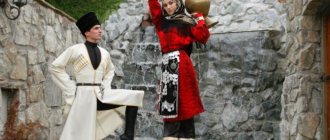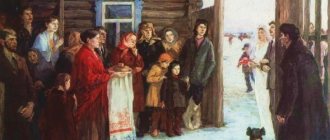The Ingush are an autochthonous people of the Caucasus, whose ancient history dates back to the second millennium BC. The life of the people has been regulated for centuries by the norms of a single moral and ethical code. A set of unwritten rules has made it possible to preserve the unquestioned authority of elders, respect for ancestors, the value of family and honor to this day.
Where they live, number
The Ingush are an autochthonous population of the North Caucasus. Most of the representatives of the nationality continue to occupy places of historical settlement: Ingushetia, part of North Ossetia. As a result of the seizure of territories by the Russian authorities in the second half of the 19th century, repressions at the end of the Great Patriotic War, a significant part of the Ingush were evicted to the Ottoman Empire, Central Asia, and Kazakhstan. The redistribution of historical Ingush territories in the forties of the last century between Georgia and the Grozny region is still the cause of conflicts among the Chechen, Ingush, and Ossetian peoples.
The total number of Ingush in the world, according to 2012 data, is about 700,000 people. Division of the people by state:
- Russia - 444,833 people.
- Türkiye - 85,000 people.
- Syria - 35,000 people.
- Jordan - 25,000 people.
- Lebanon - 20,000 people.
- Kazakhstan - 15,000 people.
In Russia, the largest number of Ingush live in the Republic of Ingushetia - 385,537 people. A significant part - 28,336 people - continues to occupy historical settlement zones, now belonging to the Prigorodny region of North Ossetia. From 1000 to 5000 Ingush live in the Republics of Chechnya and Kabardino-Balkaria, Moscow, Stavropol Territory, Tyumen and Rostov regions.
Blood feud - there is an alternative
The Ingush know what blood feud is. Revenge extended to the entire family, but more often than not, it concerned only those closest to them. There were cases when revenge could be taken within a generation, and blood feud passed on through all generations. After many realized that a blood feud could devastate entire families, measures were taken to ensure that this would not happen again.
In order to reconcile bloodlines, it was necessary to undergo a complex ritual. In order for this question not to be raised again, the blood payment had to be in material form, that is, they had to pay up to 120 cows, with the closest ones giving more than 9 cows, and distant relatives could get away with one goat. There have been cases when close relatives of the killer tried to force the injured party to peace. To do this, the child of the relatives of the murdered person was kidnapped, after which they raised him, and then the child was returned to his father and mother and given expensive gifts. After such actions, the warring parties could even become relatives. Sometimes such reconciliation and kinship were considered sacred.
Housing
The ethnonym “Galgai” arose from the traditional type of dwellings and defensive structures of the Ingush - stone towers. They formed mountain settlements located in the depths of gorges on the slopes. Combat towers reached a height of 16 m, residential towers were erected to a height of 2-3 floors. There were semi-combat structures up to 10 m high: the first floors were occupied by living quarters, at the top there were loopholes and platforms for defense in the event of an enemy attack. The towers were built from stones - a natural material that was available in abundance in the mountainous areas. The walls were decorated with petroglyphs, solar, spiral, anthropomorphic, and animal images. The signs carried a sacred meaning, addressed pagan Ingush deities, and had protective functions. On the front wall, the chief builder of the battle tower or the elder of the clan left a palm print. It was believed that it gives protection from enemies and evil spirits. More than 100 tower villages have been preserved on the territory of Ingushetia; the total number of buildings from the 13th–19th centuries is about one and a half thousand. The designs of buildings and the durability of buildings speak of the high skill of builders and architects. There was a tradition: the construction of a new tower was required to be completed in a year, otherwise it was believed that the family was weakening and dying out. The height of the structure, general condition, and number of rooms were used to assess the well-being and reliability of the family. There was a proverb: “Tell me what kind of tower your family has, I will answer whether you are worthy of my daughter!”
The Ingush are one of the most ancient peoples of the North Caucasus
Our etiquette and traditions are admirable
. Respect for elders, neighbors and relatives. And the hospitality of the Ingush is at the highest level.
I don’t think that the Ingush who live outside their homeland are different from us.
Far from home, Ingush become even more patriotic.
Wherever we go, we always take a piece of our Motherland with us. Preserving traditions and culture, regardless of where we live, is our responsibility
.
About plans
I know what I want from life. I will invest in today, learn, develop and enjoy life.
Traditions
Not only life, but also death of a person was associated with stone buildings. Another proverb says: “A living man needs a tower, and a dead man needs a crypt.” Each clan had a family crypt located near the home. The Ingush saw in this a philosophy of contemplation, reflection on the moral standards of the living. Looking at the buildings where relatives found eternal peace, it was supposed to think about the eternal, to improve the soul during life.
The crypts were built in the form of spacious rooms, reminiscent of residential towers with sloping roofs. The remains of the dead were placed here after death. The second option is small structures resembling dolmens, equipped with slits for the penetration of light and air. This design is not accidental: since the times of the Alan culture, there has been a custom according to which a dying person himself or with the help of loved ones moved to the crypt before death. Before the advent of Islam in the 19th century, in mountainous regions, old people considered it an honor to be able to reach their eternal refuge in time. Leaving the crypt was considered the greatest disgrace; it was forbidden to bring food inside. It happened that relatives visited the dying person for several days after moving to the crypt. With the widespread spread of Islam, this method of burial became a thing of the past: the dead began to be buried according to Muslim rites. The body was washed, dressed in light clothes, wrapped in a carpet and taken out into the courtyard, where those who wished to do so held a farewell ceremony. The procession moved to the family cemetery, where after prayers the body was interred. Women were not allowed in the cemetery: their task was to prepare a rich funeral dinner. As with weddings, all members of huge Ingush families, friends, and neighbors gathered for the final farewell, which took up to three days.
Wedding traditions
The marriageable age for men was 17-20 years, for girls - at 15-17 years. The bride was carefully chosen by the groom's parents, assessing the family as a whole, paying special attention to the female half. Wedding rituals began with matchmaking, in which the parents and relatives of the husband participated. To obtain consent, it was necessary to come to the chosen girl’s house at least three times. This did not guarantee a positive answer: people were not forced into marriage. On the wedding day, a wedding train arrived for the bride without the groom. After a comic ransom and a farewell ceremony with her parents, the girl was taken to her mother-in-law’s house. The older woman greeted her with honey and butter, which symbolized the wish for a sweet, well-fed life. Weddings were noisy and crowded: at least 200-500 people, sometimes the number of guests reached a thousand. Not inviting someone from your family or friends was considered an insult, as was ignoring an invitation. The celebrations lasted up to ten days. During the feast, the girl was taken to a separate room, where she remained throughout the wedding. According to another tradition, the daughter-in-law stood during the wedding feast in the corner of the hall, accepting gifts. The groom was at a friend’s house, came to the bride on the third day, then the avoidance continued for up to a month. The wedding ceremonies ended with the girl being taken to the spring for water, during which she met the residents of the village.
Ancient culture of Ingushetia
In Ingushetia, from ancient times to this day, a marriage union symbolizes not only and not so much the unity of two young people, but the union of clans. That is why the choice of a future spouse was carried out by the older generation - too many nuances had to be taken into account. In no case were marriages performed between persons bearing the same surname. Numerous family ties, twinning and adoption were taken into account. Also, economically and socially unequal marriages were not accepted, when one of the partners occupied a higher position in society. Customs of tribal feuds, clan alliances and mutual agreements were also taken into account.
Most of the marriages in the old days were carried out by early arrangement. If a young horseman or girl had not been matched in infancy, they could get acquainted on their own, after which they could present the chosen one to the court of the head of the clan. Or older relatives looked for a suitable match for young people. This custom is still preserved in Ingushetia. It is impossible to imagine young people who would go down the aisle against the will of their parents and numerous relatives. Also, divorces were not accepted and are still condemned to this day. If this happened, the shame fell not only on the spouses, but also on their family.
Appearance
The Ingush belong to the Caucasian anthropological type of the Caucasian race. According to researchers, it was this people who managed to preserve the largest number of authentic appearance features. These include:
- high growth;
- thin build;
- coarse, straight hair of dark shades;
- gray, brown, horizontal eyes;
- low protruding chin;
- the hairline is developed.
From childhood, Ingush boys were taught heavy physical activity, sports, horse riding, and handling weapons, which made them physically strong. Moderation in food was regulated by rules of conduct. Men were required to have a toned figure until old age; it was a shame to have excess weight, especially in the abdominal area. There was a special test for slimness: lying on your side on a flat surface, there must be a gap in the waist area through which the cat can get through. Female beauty was valued, but when choosing a bride, other qualities were decisive: intelligence, courage, modesty, nobility, honor, hard work, and the ability to bear children. It was the latter factor that allowed women, especially those with children or those preparing to become mothers, to have a figure that was far from today’s ideals.
Modern wedding customs in Ingushetia
Many traditions have become a thing of the past or have degenerated into stylized performances. The abduction of a bride without her consent has become an unimaginable rarity, as well as conspiracies in early childhood or forced marriages of young people who do not know each other. But, as before, there is a strict taboo on marrying namesakes. Also, modern girls and boys can see each other after an agreement, but not live together. Celebrations in cities are held in banquet halls of restaurants or outdoors. In villages, guests usually gather in one of the courtyards. The strict division into female and male halves is no longer observed, as well as the three-day ban on meeting after the wedding for spouses. And, of course, a young wife can meet with her parents at her own discretion.
A modern Ingush wedding is full of enthusiasm and fun, sparkling humor and the best wishes for the newlyweds. The Ingush people do not need a special entertainment program, because every guest here is his own toastmaster, an excellent dancer and a wonderful singer.
Cloth
Traditional Ingush clothing is of the general Caucasian type: trousers, undershirt with a high collar with buttons, beshmet. On holidays and special occasions they wore a Circassian coat decorated with gazyrs. For a long time, the Ingush papakha, traditional for the Caucasian peoples, had a conical shape, after which a version with an extended top spread. They complemented the outfit with a belt where a bladed weapon, often a dagger, was attached. A whole series of adats - norms of behavior - are associated with the dagger. It was forbidden to take out the dagger unless necessary, and once taken out, it was forbidden to sheathe it without using it. It was impossible to swing a weapon in jest. In the event of a fight, it was supposed to strike from above: long training was devoted to this until a very old age. The women's costume consisted of a floor-length white canvas shirt, under which they wore trousers. The top of the outfit was complemented by a swing dress, the festive version of which was made from expensive fabrics. The suit was belted with a leather or silver belt. The head was covered with a scarf or a traditional red kurkhars hat, shaped like a skate with a split top.
Acquaintance and conspiracy
A wedding in Ingushetia was, perhaps, the only way available to free aul youth to meet people of the opposite sex and find the desired match. At any other time, communication between single guys and unmarried girls was strictly limited. In preparation for the iconic event, the girls sewed and embroidered their own outfits and patterned scarves. And the guys tried to prepare witty sayings and an entertainment program so that they would have something to surprise their possible interlocutor. And at the matchmaking ceremony, a well-spoken tongue was also welcomed.
Realizing his feelings for the chosen girl, the young man immediately notified his parents or older relatives, because at any moment she could be matched to another family. The girl's candidacy was carefully considered. In addition to socio-economic and clan nuances, her character, behavior, reputation, appearance, health and hard work were discussed. Only when the family council gave the go-ahead could the guy begin courtship.
A simple exchange of gifts helped to ensure the favor of the chosen one. The guy conveyed it through a child or a woman, in no case personally! – small gifts: sweets, baked goods, coins. By this he expressed his feelings and hope for reciprocity. If the girl agreed, she would hand over a pair of beautifully embroidered handkerchiefs for her chosen one and his best friend. After this, matchmakers could be sent.
Life
The traditional family form is patriarchal, often small or three-generation. The youngest son remained to live in his father's house. The elders brought their daughters-in-law to their parents' house, but began to build their own home if they had the opportunity. The basis of interpersonal and social relationships was based on respect for elders and respect for ancestors, whom they knew up to the seventh generation. The head of the family was a man who was responsible for financial well-being, security, and defending the honor of his relatives. The woman occupied a dependent position, but never played the role of a servant or slave. Since ancient times, she has been revered as the mother who gives life to all things. There was a saying: “A man deteriorates - the family deteriorates, a woman deteriorates - the whole nation deteriorates.” It was forbidden to touch women even with a finger: to do otherwise meant an insult and led to blood feud. It was forbidden to swear, smoke, or fight in front of them. The persecution of the bloodline stopped in their presence; women and children were not used as victims of blood feud.
Preparation period
In Ingushetia, complete isolation of young people from each other was practiced. They shouldn't have met even by chance on the street. Usually, if the young people were from the same village, the problem was solved by temporarily moving the guy to distant relatives from another village.
The girl completely excluded communication with young people and men - after all, the bride’s reputation must be impeccable. Also, a ban was imposed on meetings with relatives of the groom of any gender, except for unmarried girls.
The only exception is minor children, with whom customs did not prohibit spending time. If necessary, it was the children who became the link between the bride and the groom or his relatives.
Both sides began an intensive exchange of gifts, preparing food for the feast and holiday gifts for relatives and newlyweds. About two weeks before the wedding date, the bride was transported to relatives or friends on the groom's side, where she awaited the start of the wedding celebrations.
Bride's dowry
Traditionally, a girl's dowry began to be collected from a very young age. She had to do a lot with her own hands: sewing, dresses, embroidery. Some things were bought or made by craftsmen of the family. The time allotted for preparing for the wedding was enough to finally decide on the dowry list, add to it, or check again whether everything was enough. Usually the bride's dowry consisted of household utensils, bedding, rich carpets and the girl's personal belongings.
Religion
The traditional religions of the Ingush were animism, totemism, and magical beliefs. The wolf, bear, and deer were considered totem animals. There was a complex pantheon of deities, which was inhabited by male and female beings. The god Dyala was supreme, and they were no less revered:
- god of thunder and lightning - Sela;
- mother of water - Khi-nana;
- goddess of fertility - Tusholi;
- mother of the winds - Mihanana
- patron of cattle breeding - Gal-Erda;
- goddess of the highlands - Mehkanana;
- patron of hunters, ruler of wild animals - Elta;
- the mother of the blizzard is Darza-nana;
- god of war - Molds-Erda;
- lord of the underworld - Estr.
In the Middle Ages, Christianity spread significantly in the region, as evidenced by the surviving stone churches and crosses. Islam begins to penetrate the region in the 13th-15th centuries, but it takes root on the plains only in the 17th-18th centuries, in the mountains even later - at the end of the 19th century.











